|

Berries of the poke plant, Phytolacca americana
(*photo
credit)
October 1, 2008
Proclaiming a
Redemption-Based Spirituality
If we are
Earth-focused, shouldn't we proclaim a highly popular creation-centered
spirituality? This form of spirituality focuses on the community of all
creatures and strives to understand their relationship to other creatures.
Fine so far, but my problem is that the matter does not stop there; the
problem reaches far beyond this insight. Part of the problem with a CCS is
that it is a partial vision, for if CCS people contrast their beliefs with a
redemption-centered spirituality and omit the latter they miss the point.
The Earth is in trouble and needs salvation -- and the act of being saved
involves redemption, and Christ is involved.
Redemption-based
spiritualities do not let people off the hook. Yes, all creation is one and
to be admired; but fragmentation has occurred through human fault -- and
this fact simply must be addressed, for our wonderful Earth is in trouble.
That unity of all creation emphasized by the CCS is ideal but our world is
highly fragmented between rich and poor. Our society allows the privileged
few to control and manipulate resources at the expense of all people. And
this is part of the trouble.
CCS is often
contrasted with a fundamentalistic view of a redemption-centered
spirituality, where the salvation of individuals in accepting Jesus Christ
as personal savior is the center of all focus and activity. Again, the
redemption-centered approach is not the total picture, but contains profound
truths that must be the basis of an integral spirituality. The very reason
we enter into the healing work of Christ is because he invites us to be
partners with him, to enter into the work of salvation in ways our ancestors
could not imagine. Today's soteological challenge (grand renewal
process) is really of a more immediate concern than championing the CCS
approach, for if we do not accept our responsibility, Earth is lost. What
is humanly damaged must be healed in great part through human effort.
A redemption-based
spirituality is necessary in presenting a positive future for our renewed
Earth. James Lovelock foresees an Armageddon (The Guardian Weekly,
March 28, 08), namely 80% of the human race lost by 2100. Why I question
Lovelock's vision is because of a need for an integrated spirituality based
on both creation and redemption, that has a Resurrection-centricity.
We cannot allow Lovelock's prediction to go unchallenged. The deeper more
integral spirituality is that we are empowered through the risen Lord,
inspired by the Spirit, and energized by the Eucharist to enter into the
saving process of creating a New Heaven and New Earth. Human beings have
damaged our vulnerable Earth through their exercise of wrongly-directed free
acts. Yes, our Creator created all things wonderfully, but even more
wonderfully restored them -- and the restoration process is now.
Prayer:
Lord, teach us the importance of being healers and how we are called to help
save our wonderful but wounded Earth.
Help us base our
activities on both creation and redemption.

Red spotted purple, Basilarchia astyanax
(*photo
credit)
October 2,
2008 St. Francis, Patron of Environmentalists
Francis
Bernadone or Francis of Assisi, (1181-1226) is the patron of ecologists and
embodies what good ecological practice is all about. Francis is not an
academic but a person who loves creation as God's gifts, sees creatures with
a sense of kinship, and initiates a process of preserving and repairing the
damage done by neglect to the environment near where he lives. He prefers
deed to word even though preaching the word has been an important aspect of
his years of ministry. The first name of his group is Preachers of Penance
-- and his deeds are worth noting:
1. The Act of
Letting Go of All Possessions. Francis is the son of a rich cloth
merchant, a typical medieval newly rich person, who regards dress and the
latest styles and colors as a mark of a chosen station in life. Francis is
expected to follow that routine; however, he rebels early on and does just
the opposite. He gives away all his worldly possessions. He puts on
garments that have the texture of sack cloth, and he wears sandals and not
shoes. He opposes the affluence of his own family and the culture of his
day. In place of affluence, he chooses to be influential without having
money or power. He breaks with the tradition of the budding bourgeoisie
or social class of freemen of medieval times, which is emerging with all the
smugness, conventionality, and materialistic practices of the dawning age of
capitalism. Instead, his deeds stress a downward mobility, a
movement spoken of in the revolutionary Magnificat, which calls for those in
high places to come down, and those in low places to move upward. He
embraces Mother Poverty.
2. Chapel
Construction: Rebuilding at the Grassroots. In 1206 Francis as a young
man goes into a neglected Chapel of San Damiano just outside Assisi in
Umbria and kneels to pray. While kneeling before the crucifix, he hears a
voice saying three times, Francis, go and repair my house which, as you
see, is falling into ruin. This begins his program to rebuild unused
religious space and to care for small chapels. After his family disowns
him, he resorts to begging.
The
Portiuncula -- The chapel of our Lady of the Angels is given to Francis
early in the 13th century to be repaired as a chapel and made into the first
church of the Franciscan Order. It is now enshrined in the Basilica of St.
Mary of the Angels in Assisi. To start small is not against his commitment
to simplicity, and so this humble beginning is that of a wandering mendicant
who still sees the need for a home base. Thus, Francis understands that
small "local" chapels are excellent places to worship. The need to rebuild
our Earth is one that starts in our own backyard. We need to realize that
Francis starts on his own -- stone-by-stone -- and others come and help
through his example. He knows the power of local demonstration, and
especially when it is something all of us can do. Francis begins, and
others take notice and join in through their cooperative efforts of healing
our wounded Earth.

Caring for a pet with a summertime bath
(*photo
credit)
October 3,
2008 St. Francis (Continued)
3. The
Habit: Demonstrating the Simple Life. Francis champions simple garb,
begging for the basics, and living a very simple life. The initial rule of
Francis is described by church historian Thomas Bokenkotter as hardly more
than throwing together a few of his favorite quotations in the Bible about
love and poverty. He receives a verbal approbation in 1209 and he draws up
the first formal rules in 1223. In contrast to Francis' simple
organization, consider the ostentatious lifestyles of the wealthy who are
able to hide their escapades by distancing themselves from their own
wasteful ways, leaving waste problems to the poor and destitute, and arguing
that it is the poor who pollute and the wealthy who have no waste.
Champions of simplicity of lifestyle realize that the affluent
deserve more blame than the poor -- the former get tax write-offs for giving
charity.
4.
Relationship with Women. The formation of Francis' second order (of
women) has a long history. About 1212 the noble lady Clare joins the
budding group that Francis is forming; she is initiated into religious life
by Francis, but only with immense discretion due to the customs of the time
and the opposition of her male relatives. Here it is evident that a
balanced ecology respects the role of women in Society. Clare plants the
seeds of eco-feminism and foresees the place it holds in the total movement
of women's liberation and the rise of environmental consciousness. Women
hold a unique position in healing the Earth, for they are often more
nurturing and intuitive; in environmental matters they are quicker to begin
something when needed. We must work to overcome major gender barriers and
inequalities because the health of the planet depends on nurturing these
relationships and working as co-equals in order to heal and save the planet.
5. Miracles:
Showing kinship among Creatures. The atmosphere of humility makes
Francis regard all of creatures as praising God. His Canticle of the
Creatures calls on Brother Sun and Sister Moon to praise God. Birds and
animals are known to have respected and come close to him. He preaches to
birds and fish, for everything from angels to rocks is part of his family.
Francis is truly catholic in trying to include and magnify -- not belittle
-- all. Among the many wonder stories of Francis is that of the man-eating
wolf of Gubbio who terrorizes the townspeople. He does not want to kill the
wolf, but rather is impelled to go and reason with the beast. The wolf
guarantees that, if fed, it will not harm anyone.
6.
Pilgrimage to Holy Land: Collaborating with Others. In 1219, Francis
makes a pilgrimage to the Holy Land and Egypt and even preaches to the
Sultan. Francis is known for making a wide variety of friends and gains
respect through his personality. He opposes the stance of warfare in place
of dialogue and is really the first to open up interreligious interaction.
Today, The Society for the Protection of Nature in Israel (SPNI) is
one interreligious group operating openly in the Middle East and thrives to
care for the threatened environment of our Earth.
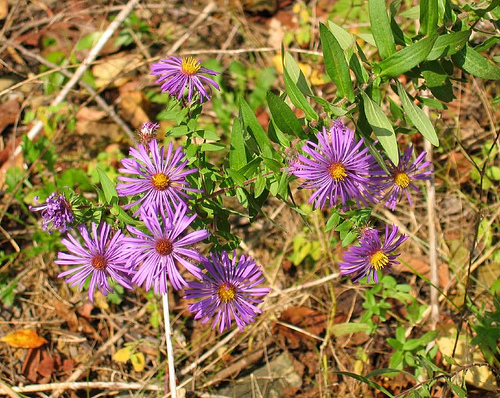
Aromatic Aster oblongifolius
(*photo
credit)
October 4,
2008 St. Francis (Continued)
7. The Crib:
Teaching Children Profound Mysteries. The genius of Francis stands out
in his creative act of celebrating the Lord's humble birth through deed and
not just word, namely in the presentation of the event with live people and
animals. The custom of erecting cribs is ascribed to him. In 1223, he
obtains permission from Honorius III (1215-1227) to use the crib and the
images of the Christ child, Mary, Joseph and Wise Men to re-present the
mystery of the nativity -- a creative pedagogical tool. Today,
environmental education attends to children -- the hope of the future.
Children must start a down-to-earth repairing process through caring for
animals and plants, constructing nature trails, and planting trees. The
profound mystery of the Incarnation, taught through a simple crib, reveals
the marvels of Creation, Redemption, and Renewal -- the threefold or
Trinitarian work of Earth caring. Open wonder, heartfelt vulnerability, and
playful enthusiasm recreate the wounded Earth. Plants and animals reveal
creation in its depth, redemption in its need, and renewal in its spirit.
8. Stigmata:
Welcoming the Marks of the Lord. Francis' love for Christ is so intense
that he is blessed with the marks of the cross on his very person. This
phenomenon, granted to few others, begins in September, 1224 just two years
before his death. He becomes one with the suffering Christ glorified on the
cross on his person. Caring for the Earth must be coupled with social
justice issues; we are hurt by the desecration of the Earth, and we
perceive suffering people and suffering Earth in an intimate, unbroken
relationship. We cannot solve the Earth's environmental problems without
first solving our social ones. Eco-suffering becomes a challenge, and when
properly understood, becomes an opportunity. It is our modern day stigmata
-- the markings of the crucified Jesus in the Body of Christ in Earth and
all sufferers.
9. Deacon:
Serving Others. Francis is one of the famous deacons in the Church,
whose ranks include the martyrs Stephen, Lawrence, and Vincent. A deacon
gives special service to the Church; Francis fulfills that role perfectly,
both through preaching and in humble service to the poor. Caretakers of
the Earth are concerned about the human family and other creatures; they do
not want to be overlords. This service includes healing the wounded,
preserving the threatened, nurturing the stressed and ailing, and
demonstrating to others how they can be of service.
10. Smiles:
Dancing in Celebration. Francis loves to celebrate -- to skip down the
road when traveling, to smile easily, to sing and converse. He is
lighthearted throughout his life. He is generous to a fault, poetic, a
high-spirited youth who dreams of performing daring deeds of chivalry. Yes,
there was a brief disillusioning career as a soldier. But by taking on
Christ Francis manifests the sheer wonder of God's goodness through song,
dance, and an engaging personality. His love for celebration extends to his
growing fellowship, which is so vast today.
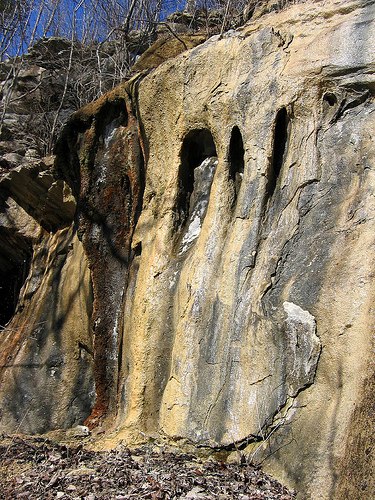
Travertine on Limestone, Carter Caves State Park
(*photo
credit)
October 5,
2008 Counting the Blessings of the Vineyard
There was a
property owner who planted a vineyard, put a hedge around it, dug out a vat,
and erected a tower.
(Matthew 21:34)
The rest of the
parable just quoted tells how ungrateful the tenants were and how they
mistreated the servants sent to receive the harvest. Thus this parable has
two components: God's care in creating good things for us all; our
frequent ungratefulness and unwillingness to share the gifts given.
However, when we come to recognize God's gifts in their uniqueness and
appreciate them more fully, we enter into the divine family all the more and
take part in God's caring exercise over all creation. We become
participating partners through an atmosphere of gratitude -- and this gives
us cause to rejoice and celebrate.
Vineyards are
beautiful to behold but never more so than at harvest time. The spring's
new shoots have a certain beauty as do the summer's vines and green
clusters, which start the long ripening process. Harvest time involves work
but is also sheer joy when bringing in the fruit of the vine to turn into a
product of great value. It is a sacred moment when we can sing out in
gratitude to the creator of all things. To think that only one planet has
yet been found that sustains this bounty of life and that this life is so
pleasant to behold -- God's gift to us.
Thinking back,
each of us can recall bounty at autumn harvest season and we know our
feelings are unique. In fact, we delight when others have such bounty or
when we are the ones who are so blessed in our specific locality. Vineyards
take tender loving care in the digging, planting, tending, and harvesting.
Every grape has had its share of this care, an investment of human love. The
final product, the wine is more than a purifying agent; rather it is
something that has its characteristic aroma, taste, color and feel upon the
tongue. The Lord gives us something to celebrate in the bounty of harvest
and has invited us to enhance the gift through our own human efforts. Wine
constantly reminds us that God invites us to enter into the creative
process.
I will always
remember the single experience of an Alsatian wine harvest, the weekend
festival of the new wine at Saint Hippolyte, the sight of the ripened grapes
and the busy laborers preparing for the wine-making process. It was an
experience that my grandparents desired to recreate when they came from the
"Old Country" and wanted to start a vineyard here in the Ohio Valley -- the
heart of wine-growing America in the 1870s; here the gentle hilly landscape
and climate resembled the land of their birth. A terrible blight in the
vines of the late 1800s cut short their dreams and so they resorted to other
types of farming -- and grapes and vineyards were left to the memories
alone. C'est la vie!
Prayer:
God, giver of all good things, we thank you for these gifts and we show our
gratitude through genuine celebration with others.
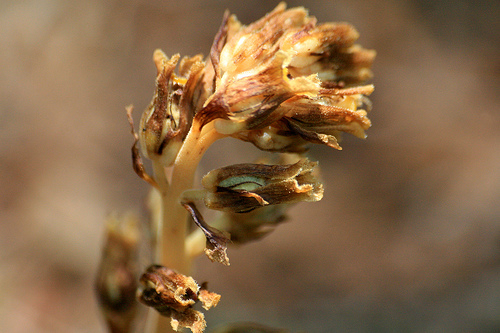
Pinesap, Monotropa hypopithys
(*photo
credit)
October 6, 2008
Learning through Autumn
Gardening
Gardening can be
a learning experience -- for both master gardeners and beginners. The
autumn time, as the gardening season winds down, is a good opportunity to
review how things went during this past growing season. Nothing is perfect
whether weather or the sprouting or the yield of certain crops. I had poor
spinach and leafy crops but excellent yields of onions, peas, tomatoes and
zucchini. Some things go well and some not so, and we thank God for good
things and learn how to improve on the others. Over time, we come to
respect nature by enduring the vicissitudes of the elements, accepting
mini-disasters, weighing opportunities to plant other crops, and minimizing
crop damage through patience and alternative interplanted crops.
We learn to
master the growing seasons: when to plant, thin, weed, interplant with other
vegetables, mulch and harvest. Proper sequencing of vegetables and herbs
becomes second nature, because the master gardener knows the climate, soil
conditions, what grows best, and how much space is needed at harvest time.
Together, the experienced and the beginner can rejoice in a satisfactory
harvest. The beginning gardener learns very elementary things when working
the soil and advances rapidly in the art of gardening. Besides the facts
of plant life, all experience a growth in patience and gentleness in dealing
with the creature world.
The beauty of
gardening and the potential for growth in knowledge affects master and
student alike, for the garden is a source of expanding wisdom to all, a seed
bed for the teacher and learner, but also for the non-committed visitor who
does not really fit at first into the teacher/student category. The garden
stands out as a powerful demonstration to all who come near. Gradually,
each interested person is drawn into moving from the level of observer to
participant in the mystery of gardening, a mystery that takes on the
character of respect for land and all of God's creation. This relationship
expands to healing or restoring the garden plot as a foreshadowing of
healing our planet in a cooperative effort.
Passing
gardening experience from expert to inexperienced is an ongoing process.
The well-tended garden becomes a model, a New Eden. Land becomes more
productive and that is exciting, and the excitement spreads to other
learners and neighbors. The starting point is a single location -- a yard,
a plot, a neighborhood, an enzymatic point of action. From there the idea
spreads to peopled places -- a town, a county, a state, a region, a country,
a planet. Learned responsibility for a small place becomes accountability
for progressively broader environmental areas. Yes, many simultaneous
beginnings will be possible and are occurring right now.
Prayer:
Lord, allow us to see that gardening is part of our journey through life;
we always have more to learn and gratitude for what we attempt in every part
of the growing season. Help us see this phenomenon as part of a world
movement to heal a planet.
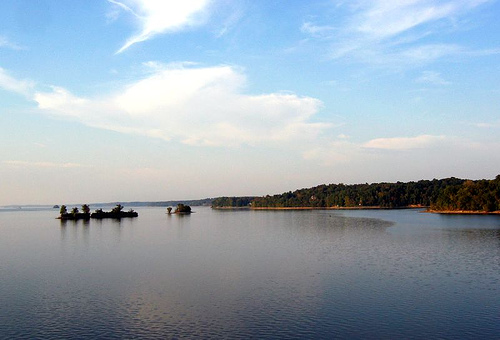
Crossing Lake Barkley from Cadiz, KY
(*photo
credit)
October 7,
2008 Providing Proper Lighting for All
As the days get
noticeably shorter, October is the perfect time to recheck our lighting, for
energy savings by means of lighting is poor conservation if we damage our
eyesight in order to save on electricity. Our eyes need good light to read
so we can avoid any possible strain. Good lighting can serve as more than
an ornamental effect; it can increase security, general mobility, and close
work or reading. A type of lighting used as a heat source for baby chicks
or for keeping pipes from freezing is okay but a poor use of energy; it
shows how wasteful older lighting has been.
Today we are
aware that energy conservation and lighting go hand in hand. In many
domestic establishments the use of energy efficient bulbs proves a major
savings. Some say that the general use of compact flourescents alone would
eliminate the need for forty large-sized powerplants in America. Some state
and local governments as well as utilities offer compact flourescents at
very low prices, sometimes less than one dollar each. Remember that
incandescent lights burning constantly in Exit signs are small, but the
total amount of energy can add up over time. Timing devices can become big
energy savers in institutions where people take little responsibility for
lighting, and vacated space is overlooked by maintenance personnel.
How do you get a
nation to change its light bulbs? If you are coming in and going out, turn
off fluorescents only if the room will be vacant for a couple of hours.
Where possible we ought to consider light-colored walls, which assist in
reflecting the light for those wishing to read. Consider doing reading and
close work using natural lighting though that become scarcer with the
shortening autumn days. Consider installing natural lighting skylights or
moving the chair closer to the window. Outdoor lighting is necessary for
security and for guidance when traveling. However, too much of a good thing
can cause "light pollution," or the glow that keeps us from seeing the Milky
Way at night. So often people add ornamental lighting not only during the
holiday season but year-round. Some of this is especially wasteful, if
little attention is given to the inefficient bulbs. Consider the
installation of solar Photovoltaics as a good use of renewable energy
sources as well as a means of providing the desired outdoor lighting.
One saving that
is often overlooked is that only sections of a room need to be lit for some
operations -- not the whole room. Often, overhead lights can be replaced by
a small desk light or floor reading lamps. Residents can buy a portable
light meter at local electronics outlets and use this device to determine
whether enough light is present, not just at or near a window, but at your
favorite location for night-reading. Efficient lighting is at the front
line of conservation measures.
Prayer:
Lord, You are the light of the world; help each of us to become a source of
light to the unenlightened.

Peering into the treetops along a road lined
with black walnuts (Juglans nigra)
(*photo
credit)
October 8,
2008 Striving to Be and Remain Debt-Free
"Believe me, I
don't like all these debts." Such a remark is heard in troubled financial
times from a multitude of mortgage holders, credit card users and those
unfortunate enough to have acquired a massive health bill. Indebtedness is
not to our liking, but it has much to do with a mentality that is to put off
to the future by engaging in unsustainable ways today. The ill effects of
this pay-later mentality are all too obvious today on our local, state,
national and global levels.
I grew up
thinking debts a bad thing, and for thirty-two years ran organizations that
were never in the red. Being credit card free I suggest the follow rules to
stay debt-free:
1. Plan within
your expected budget and try to keep with it. Set a contingency plan in
case the income is less than expected.
Plant gardens for
food, defer capital expenses, and undertake do-it-yourself tasks (home
repairs) that save money;
2. Refrain from
impulse buying. Failing to think before one buys is a common cause of some
indebtedness. Ask whether you really need this item or whether it can be
deferred until you think about and talk over the proposed purchase. Many
times this impulse can be remedied by existing or far cheaper alternatives;
3. Avoid credit
cards. Unfortunately today many people say they can't and that says much
about our economic system. People permit themselves to get a ten thousand
dollar non-home indebtedness and simply forget that the debts will come due
in a short time with their hidden high interest and processing rates. It is
really not that hard to carry cash; doing so makes us more reluctant to buy
than when using the handy credit card;
4. If you are
starting up a household consider building in a place where you can do it
yourself. The massive savings from building one's own house even on an
incremental level over a decade are astounding. A house mortgage will take
many good years of time and income to pay off. Amazingly, do-it-yourself
building becomes a ticket to a simpler living consciousness;
5. Attempt to
be less "up-to-date" in everything from electronic gadgetry to automobiles.
Staying with a proven product a little longer amounts to a significant
savings over time and makes one less prone to faddish purchases. We do not
need to be wired with the latest cell phone and related amenities.
6. Think savings
and regard them as part of our normal economic life. If already saddled by
a major debt, try to get it refinanced and develop a repayment schedule that
is reasonable and stick to it as best you can. Best wishes!
Prayer:
Lord teach us that fiscal conservatism is part of my act of faith in the
future that we must spread to others, if we are to survive as a people.
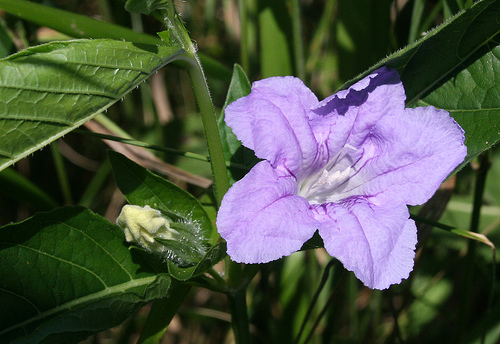
Ruellia strepens, Franklin County, KY
(*photo
credit)
October 9,
2008 Challenging the Slipping Memory
One of our most
precious possessions is memory, and with aging we see it slip in many ways.
Reminders on posted notes of events, people, phone numbers and appointments
litter my walls; they are so many I forget where different reminders are
located. For efficiency I try to counteract memory slippage as follows:
1. I update the
daybook just before the beginning of the month by listing all the activities
that I can anticipate for the coming month. At each weekend I prepare for
the coming week and do the same for the day with a time period at the end to
recall and thank God for what has been achieved.
2. I strive to
recall things from the past. The sound mind is the best repository, and it
needs exercising at all times. Youthful memories can become distorted but
still are worth recording and going over to sharpen with time and
verification by others with better memories. I remember well ole Joe Davis
(Special Issues), who, in turn, remembered the start of the Civil War, which
occurred over 147 years ago. Yes, the numbers of those who know someone who
remembered the Civil War are dwindling and we are becoming a remnant.
Memories are fragile, and story-tellers can warp and mold the past with
relish, but they are needed.
3. I undertake
a recall exercise, namely the names of about 3,000 counties, towns, and
geographic locations in the United States (one for every hundred thousand
people), and when travelling, I recount the names in selected states to
ensure retention. Granted, slippage occurs, but new names compensate.
4. I realize
that memory retention is not an individual task alone. Communal recall at
family gatherings and conversations helps keep the living memory alive among
social groups and becomes more valued with aging. We need to preserve our
memory of good times and good people who have passed through our lives. We
need to consider the role of archives in retaining our past with a certain
amount of collective respect. Thus we should set aside places to keep our
memorial items for those who follow.
5. We have much
more today to assist us in recall than did the oral traditions of the
past. Photos are good memory triggers, and these ought to be annotated as
to time, place and people. The same applies to video and audio tapes as
well as written records, all kept in places where they can be easily
retrieved.
6. Certain
foods, medicines or natural herbs may help to keep the memory alert. One
elder with good memory takes a sprig of parsley each day. Maybe there are
other health hints but they and their proponents slip my mind.
Prayer:
Lord, we thank you that we can recall the great deeds You have done for us,
and in this spirit of gratitude we make an effort to keep our sacred
memories alive for those who come after.
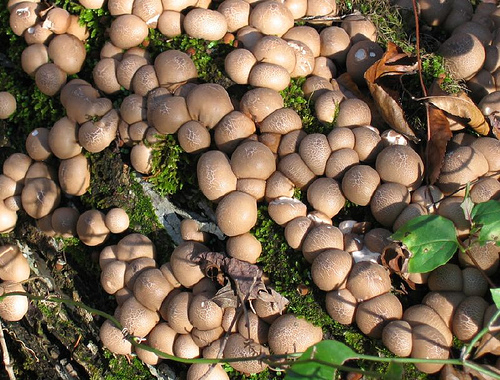
Lycoperdon pyriforme, puffball fungus.
Cedars of Lebanon State Park. Lebanon, TN.
(*photo
credit)
October 10,
2008 Burning Down the Place Seventeen Ways
Unfortunately I
have lost the attribution of this listing, but the listing has been in my
files for years and any copyright would have lapsed. During fire prevention
month this may be a good reminder of what to avoid. We can start unwelcome
fires when we --
* Use a little
gasoline to start the fire.
* Hook up the
stove to just any chimney.
* Don't bother
reading installation and use instructions.
* Don't screw
stovepipe sections together.
* Install the
stove ourselves with no prior expertise.
* Save by not
buying a smoke detector or fire extinguisher
* Stack firewood
and kindling close to the stove.
* Forget about
proper floor protection under the stove.
* Leave stove
door open when we go out for more wood.
* Burn trash in
the stove. Plastic is combustible.
* Burn imitation
logs in your stove.
* Put our
freshly cleaned-out ashes in a grocery sack and set it out on our back porch
or wooden stairs.
* Build a hot
fire, load up the firebox, leave the damper wide open, then go to town or go
to bed. Keep peace of mind.
* Permit the
little kids to fool with the fireplace; they are naturally attracted to
fire.
* Don't inspect
and clean out our stovepipe and flue regularly; if it was good last year it
will be this year also.
* If you have a
chimney fire, don't call the fire department. It is an easy way to clean
out the chimney. Creosote build-up is quite combustible.
* Install a
stove in our mobile home, even though it is not UL-listed for such use.
Note: These
are to be AVOIDED and not followed but that may not be obvious to a few
readers. We really don't want you to start a fire at your home.
Prayer:
Lord, teach us how to use fire as you did our forebears -- and to respect
its potential for benefit and harm.
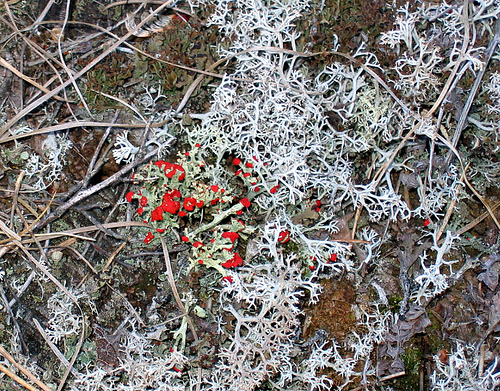
Cladonia cristatella, British soldier lichen.
Newberry, MI.
(*photo
credit)
October 11,
2008 Discovering Backyard America
Tomorrow we
celebrate Columbus's "discovery" of America. We may find it somewhat
colonialist to speak of the European discovery as though nothing happened
without that awareness. Perhaps autumn is a good time to "discover" or gain
a better awareness of our own locality and what it has to offer. High fuel
prices may facilitate some of these possible discoveries:
* Wildlife.
Get a bird book and observe the many species that are passing through on
points south for the winter. October is a time in this part of the country
when (as in April and May) we see greater variety of semi-tropical species.
It is a time to learn about bugs and spiders that are busy preparing for
winter.
* Trees.
Do we know the names of all the trees of color we are experiencing right
now? In this part of America we have over one hundred species of native
temperate trees and that does not count the exotic ones that have been
brought here from elsewhere.
* Land
formations. As the leaves fall the open landscape becomes more visible
and the geological formations become more pronounced. Take an elementary
course in local geology -- rock formations, cliffs, watersheds.
* Historic
sites. The wanderlust spirit is widespread and needs to be satisfied,
especially among young and those young at heart. Don't overlook local
parks, museums, and historic and scenic spots. Draw a circle of one hundred
and fifty miles (three hour drive) and identify sites that you have not
visited. Do a Google search to gather basic information before the venture.
* Nature
ventures. Take a nature hike to enjoy the scenery, fresh air, sounds,
smells and tastes of nature. Gather some persimmons, elderberries and
hickory nuts, the other wild foods that are now in season. You may prefer
to do this by foot or by bike if the roads and your agility permit. Some
may even try it by boat, row boat that is.
* Festivals.
This is the time of year to go to the fairs and festivals for it is not
as uncomfortable as in mid-summer. If you are lucky you can learn apple
drying, honey tastes, herb preservation and soap-making the old fashioned
way.
* Heavens and
Earth. Obtain, borrow or use a telescope and look out at the macrocosm,
especially if you live in the shrinking part of America with no light
pollution. An alternative is to look in a microscope at the vast microcosm
below our feet.
* Memories.
Keep a record of your ventures; they are worth reviewing when weather turns
bad and you are temporarily immobile.
Prayer:
Lord, guide us to discover the variation and grandeur of all the things
around us, and to grow in appreciation.

Fagus grandifolia, American Beech. Franklin, TN.
(*photo
credit)
October 12,
2008 Inviting the Uninvited
Go to the
crossroads in the town and invite everyone you can find to the wedding.
(Matthew 22:9)
We live in a
world of the overlooked, the left behind, the marginalized, the little
people, and the forgotten. These are the vast masses who are all too often
the uninvited. If all people were truly invited to the world's bounty and
were able to share essential resources, peace would soon come to our
troubled planet. In the modern political and economic system in which we
live, some have a special invitation through authorities due to their
influence, power or wealth; others are totally overlooked, and others are
not specifically invited and lack that access to what is the commons. The
banquet tables of this world are certainly limited and are filled with
expensive things.
A banquet
includes the following: the gathering of those who are to celebrate; the
feasting on special foods; and the socializing that occurs during the
feasting:
The gathering
in God's kingdom includes all to come and is not limited to a privileged
few. A democratic procedure means gathering all that are to be found and
not really overlooking anyone. Melville says in Moby Dick, "I am a
man running out of time." The time is right to make the harvest bounty
available for those who are hungry -- for time is of the essence. A hungry
person needs food here and now and so the gathering is imperative.
The feasting
may seem ordinary to some who feast regularly and sumptuously. If people
have different degrees of feasting where some have rich fare and others the
most humble, the banquet is not a shared feast. We are all called to share
the bounty in such a manner that food is regarded as a commons benefitting
all in adequate proportions. Feasting on rich foods is to be occasional as
a celebration for all, not the daily fare of the privileged.
The
socializing aspect means that those who are at the table have a
responsibility to continue to share as brothers and sisters and to act in a
respectful manner. God prepared this Earth during billions of years for our
arrival and presence. In only an instant of geologic time, we have misused
it and grabbed what we can without regard to those who are speechless and
hidden from public view or the future generations who are also invited. God
created all so that in some moment, when not required or pressured, we find
time to say "thank you." This free act of thanks, which only human beings
can give, is the pinnacle of creative action. It is time in this urgent
moment of social and environmental crisis to return to the banquet table and
appreciate the attitude that allows all to enjoy the food that is meant for
all the people. Part of our enjoyment is to be compassionate and respectful
of gifts given.
Prayer:
Oh God, you give to us the abundance of this Earth for our livelihood. Help
us to share this bounty with all people.
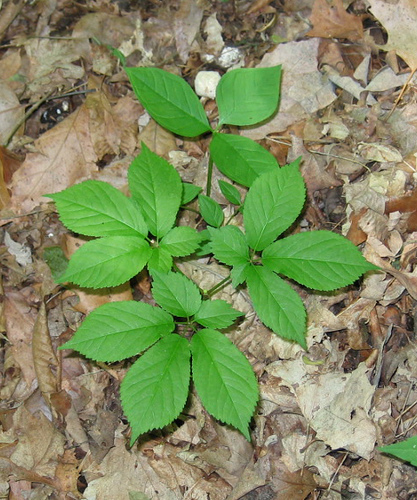
Ginseng, Panax quinquefolium,
Vernon Douglas State Nature Preserve.
(*photo
credit)
October 13, 2008
Focusing on Ginseng, a Tobacco Substitute
Autumn is a good
time to start planning for next year. We are in a part of the country where
the dependency on tobacco was once greatest, that is, many small farmers
made their living from raising small patches of tobacco. However, things
have changed in the past few years with reduced tobacco sales and
outsourcing to foreign lands. Growers search for a replacement for their
lost tobacco livelihood. This is an opportunity to find some more healthy
alternatives and one of these is American ginseng (Panax quinquefolium),
a native plant in the eastern United States.
Virtually-wild
ginseng grower, Syl Yunker, tells us that his fresh ginseng (far more
weighty than dried roots) brings him an astounding $850 a pound on the
current market. With the rise of fortunes and medium incomes Chinese engage
in their ancient relationship to ginseng and strive to obtain ginseng's real
and supposed medicinal benefits and are willing to pay. Air freight can
move the local ginseng to these distant markets with ease and so the sky
seems the limit. However, the scattered wild plants need protection, and a
market system needs to be accessible to the average small grower or "sanger."
Problems do
exist for the ginseng growers. First, there are the free ranging turkeys,
for multitudes of these semi-wild birds are proliferating in our country;
they like ginseng berries as well as most other forest understory
vegetation; they come through as efficient reapers, crush the seeds in their
craws and do not pass out the seed intact as do other smaller birds.
Poachers are as much a problem as are turkeys. Gatherers and growers often
do not want to be identified as that will alert poachers who are ready to
move in and dig up the ginseng. This means legitimate growers and gatherers
prefer a more private marketing system and yet they need proper marketing
information. Irresponsible poachers are enticed by quoted high prices;
these fly-by-nighters can easily retard wild ginseng propagation by
gathering immature plant roots and by not waiting until after the
seed-bearing period in late summer.
Both sets of
problems can be addressed. The turkeys are local home-grown meat that is
quite healthy as well as plentiful in areas where commercial meat is
expensive. We need to get the hunting season liberalized and extended so
that these game animals can become food for our hungry local people. The
poaching problem can be addressed through a registration system, which
allows federal marketing cards to authentic growers or harvesters (on lands
where permission is obtained to gather wild ginseng properly); then the
ginseng can be marketed more publicly with less risk of poachers (who lack
proof of registration) being in competition or stealing plants. However,
such a system will take legislative action on both the state and federal
level.
Prayer:
Lord, you have given us many plants that are healthy for us and worth
harvesting in sustainable ways. Teach us how to make better use of the
gifts we have around us.
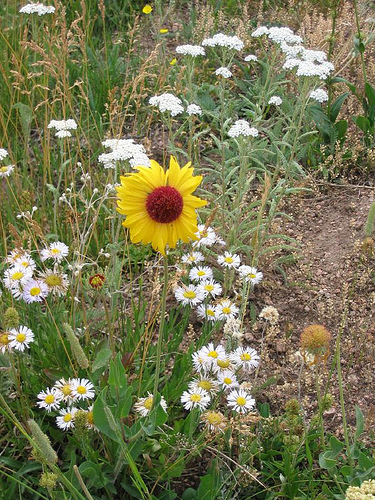
Asters in a field, near Cheyenne, Wyoming
(*photo
credit)
October 14,
2008 Harvesting Nature's Produce
With high food
prices we need to become familiar with the major wild supplements available
to our diets. Urban wildcrafting is more difficult than the practice in
rural and sparsely inhabited areas. We can gather greens, especially in
spring, berries and fruits in summer, nuts and seeds in autumn, and roots in
wintertime. Natives know and gather sustainably so that others can do so
later but the selfish ones are not so careful.
Greens
-- Springtime is perfect for nutritious supplements since there are so many
in that season. Still some greens such as plantain and sorrel and can be
gathered throughout the growing year. We need to know which wild plants are
edible and nutritious.
Fruits and
Berries -- Mayapples, papaw, mulberries, wild cherries and plums,
crabapples, fox grapes, and persimmons are delicious native fruits; they
are generally not subject to becoming overharvested as in the case of
roots. A major portion of wild fruits and berries in our region go
unharvested. Rose hips and sumac tops furnish Vitamin C drinks. Wild
strawberries, raspberries, gooseberries, dew and blackberries, blueberries,
and elderberries are available in our part of Kentucky, and many other
berries are found elsewhere in America. Protective gear is recommended in
berrying in order to overcome briars and poison ivy and avoid snakes.
Fruits and berries make excellent wine, cobblers and other deserts; excess
produce can be preserved as juices, jams, jellies, frozen treats, or
leathers.
Nuts and
seeds -- A great variety of nuts and seeds is produced as nature's way
to store fats, oils and proteins for the upcoming winter season. In
October, many nuts are ready for the gathering, once the nut bearing trees
are recognized -- hickory nuts, black walnuts, butternuts, hazel nuts,
acorns, even chestnuts. Don't over-gather. Leave adequate mast for the
wildlife, which depend on these delicacies. Removing walnut hulls can stain
the hands, so either wax the hands before beginning or regard the temporary
condition as "clean dirt."
Wild and
Cultivated Roots -- Some natural roots such as sassafras, ginseng,
dandelion and wild chicory roots have proven uses as flavorings, medicinal
herbs and substitutes for coffee. In milder climates, root crops can be
left in the ground for late harvest -- horseradish, parsnips, carrots,
Jerusalem artichokes, turnips and rutabagas -- if mulched in later fall.
Here again a caution is given to the "wildcrafter." In gathering wild
roots, overharvesting can threaten popular species. Get proper landowner's
permission; gather in a sustainable manner so as not to damage the flora on
the landscape; and gather only what is needed for use.
Prayer:
Lord you give us food in all the seasons, if we but put our mind and heart
to discovering these gifts and use them respectfully.
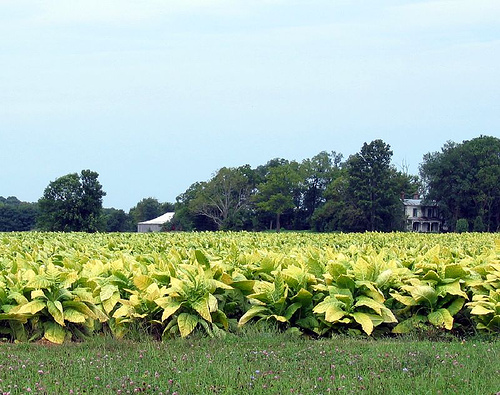
Family-owned tobacco farm in Nelson County, Kentucky
(*photo
credit)
October 15,
2008 Preparing for Possible Disasters
Autumn is
preparedness season and so, as we make ready for the winter season, we may
review how we would proceed in case of disasters or emergencies, i.e.,
storms, floods, fires, terrorist attacks and accidents. At such a time our
preparedness will come in handy. We should think of preparation in terms of
four components: Does the alarm system work? What do we take quickly with
us upon departure? How do we evacuate the immediate place? And how do we
evacuate from a threatened vicinity?
* Alarms.
Warning systems are generally in place. We have such emergency signals here
in case a nearby chemical weapons depot should spring a major leak. In many
places radios or phones can be activated in case of emergencies. Make sure
escape routes are known and unencumbered. Sometimes the sirens or alarm
devices are used for other activities or celebrations and they may even be
ignored through overuse. Know when these are tested at set times in the
month and recognize the noise they make. Don't buy just any residential
fire alarm, but one that alerts you when batteries are low. Choose from a
variety of alarm systems that do not have radioactive materials present as
part of the detector devices.
* Evacuation
supplies -- Some folks like to consider what to take: their billfolds,
medicines, papers, computer materials and necessary clothes, if time
allows. Some people keep an emergency pack at a relatively safe place to
pick up quickly; this may include a bottle of water, flashlight and
batteries, small radio, waterproof container and matches, small first aid
kit, and flares along with sleeping bags and special clothing.
* Immediate
escape routes -- Provide the place with fire extinguishers, smoke
alarms, safe storage of highly combustible solvents, and proper electrical
wiring. Rope ladders in each of the second- or third-story rooms may be a
worthwhile addition. Fire drills are generally practiced at schools
several times a year. These ought to be taken seriously. Are the disabled
able to escape easily from their place of residence? Put stickers on
windows where infants or youth have bedrooms as flags for fire fighters and
evacuating personnel.
* More remote
escape routes -- In our county we receive calendars each year showing
the assigned routes to be used for evacuation by people in various
residential zones in case of emergency at the chemical depot. It is
presumed that all have access to vehicles for such movement and that schools
are evacuated by designated school buses. Senior citizen homes and
hospitals are more problematic; we need to volunteer to help in such
emergencies.
Prayer:
Lord, teach us always to be
prepared for what comes in our lives. Allow us to have the temperament
needed to meet the unexpected and to be ready to cope with emergencies and
to assist others in time of unexpected need.

Abraham Lincoln: New Salem State Historic Site
(*photo
by Mark Spencer)
October 16,
2008 Establishing Local and Family History
The First
Hometown History Primer (America the Beautiful Fund, Washington, DC:
Wagner Paperback Library, 1973) suggests the following local history
projects, which are still good hints:
* Keep a diary
in some readable format;
* Assemble a
history of your past schooling -- teachers, classmates, class pictures,
report cards, programs;
* Draw a time
line with important events from your life listed on it. Allow places to
write in events under each year or decade;
* Return to your
childhood home and your roots;
* Gather family
pictures and give photo albums for presents;
* Make a family
residential map and trace immigration routes;
* Visit graves
of your loved ones;
* Start a family
tree, and commission someone to be the family or local historian. Remember
that for each generation the tree branches all the more -- and record
keeping becomes more complex;
* Make a tape as
part of a living oral or video history of the older member of the family to
keep for posterity. Keep and distribute copies;
* Collect and be
sure to pass on family archives, which include documents, special heirlooms,
youngster's artwork, baby books, pressed flower reminders of important
events and other keepsakes;
* Record your
home place(s) with photographs or paintings. Detail all aspects of your
home life and the surroundings;
* Make cave art;
design a basement wall where graffiti may be allowed and encouraged. Here
the youngsters can record themselves;
* Have a
periodic family reunion at a convenient place where all can assemble
relatively easily. Hopefully this will not just occur at funerals and
weddings.
* Keep a family
Bible or other family record up-to-date. Allowing these records to lapse is
a mistake, for our memories lapse as well; and
* Take a weekend
tour to familiar sites and invite friends. Consider antique shops, an old
inn, museums, or a country fair.
Prayer:
Lord, show us how to have a sense of belonging and yet pass on to others the
things we cherish at this time.

Autumn leaves
(*photo
credit)
October 17,
2008 Observing Fourth World Day
The so-called
Fourth World is the poorest of the poor and includes people in such lands as
Haiti, Somali and a number of the nations of Sub-Saharan Africa. Often
these are failed states where political structures are unable to cope with
problems of hunger, disease, inadequate shelter, bad drinking water, and
malnutrition. Here immediate relief must be in the form of direct
assistance with every intention to move to longer range development programs
when conditions will allow. We can address Fourth World problems on three
fronts: know the immediate poverty problem, resolve to share resources, and
give through radical sharing of what we have.
The primary
level is one of experiencing the needy in their hungry condition. Direct
food assistance is never perfect and arguments against putting people into
the position of permanent charity cases are often voiced. We have this
problem facing us here in Appalachia in very real ways, and a Christian
sense of assisting the needy impels us to act here and now -- for the needy
can hardly wait. If still more information is sought, you may wish to get
acquainted with the "Fourth World," an organization dedicated to making the
world's poverty problems known to the general public. For further
information visit the website <www. fourthworld.org>.
The second level
is to become sensitive to what we have in excess -- our own condition of "affluenza,"
or a condition of using up more than our share of resources. Since 1950 we
Americans have used up more resources than everyone who ever lived on Earth
before us; Americans spend more each year on shoes, watches and jewelry
($80 billion) than on higher education ($65 billion); Americans visit more
shopping centers each week than houses of worship; Americans spend nearly $6
trillion a year, more than $21,000 per person, mainly on consumer goods;
there are more cars in America than registered drivers; during the 1990s
half of all new cars sold were SUVs and light trucks, exempted from federal
fuel efficiency standards; and by the time Americans reach seventy, they
spend three years of life watching advertisements. Too much, too much!
The economic slowdown
may help us return to our senses.
Poverty
separates the world family and leads to dissention and discord. We ought to
share in a radical manner, replacing luxury expenditures by giving to those
who lack essentials of life. Share a portion of one's food budget to
support needy individuals (such as orphans or widows) and live on less
either through garden produce or through simpler food choices. The sharing
can be initiated through direct contact with relief agencies: Oxfam, the
United Nations Children's Relief Fund, Charitas or Catholic Relief Services,
or (my favorite) Catholic Near East Welfare Association <www.cnewa.org>
1011 First Avenue, New York, NY 10022-4195.
Prayer:
Lord, teach us to enter more deeply into the lives of our suffering sisters
and brothers and become one with them through radically sharing our budgets
with them.

Kentucky sunset
(*photo
credit)
October 18,
2008 Tackling a Turnover of Yard into Garden
Rising food
prices and a growing shortage of foodstuffs in various parts of the world
make us more conscious of the need to convert lawn into edible landscape.
But this is always easier said than done. You may be a gardener but others
are not, and it will take effort to make them change their lifestyle. How
do we encourage them to dig up their yard and make this highly cultivated
lawn grass into something beneficial for others?
First, face
reality. A lock-step uniformity exists with lawn care in our country: lawn
type, height, evenness and greenery. No one wants to deviate from these
established norms. Each community member is expected to conform to the
majority -- a lawn-loving crowd. The neighbor's green lawn adds to the
economic value of one's property, and so any deviation in landscape is
considered to harm economically all on the block. Community relations
become strained when conformists regard lawns-turned-to-gardens as matters
of disarray and deviancy, places filled with unrecognizable plants of
various sizes, shapes and colors -- and spaces that change dramatically with
the seasons. For such folks, deviation from modern standards leads to
disorderliness.
Answers are
often better understood by youth who catch the point faster than conforming
adults. The seemingly messy or natural in contrast to artificial landscape
may be what birds and butterflies find inviting. Variety of vegetables and
flowers can be compared to an oil painting in contrast to a totally
monocolored board; a grove of various fruit trees is more interesting than a
monolithic stand. A garden in seeming disarray is the beginning of
something more natural and challenging. An advocate of alternative
gardening must make the risk of change-over convincing through gentle
persuasion. In fact, meticulous lawn-carers may find modern gardening
daunting. "What if people laugh at my gardening?"
The gardener
brings a social and a technical message, a need to grow one's own food at
the risk of being laughed at. Creative conflict arises from differing
concepts of community land use (whether ornamental landscape or vegetable
gardens). This may involve confrontation with various departments of a
municipal government -- as happened with a friend in California who was
plagued by agencies and neighbors because she installed a native plant
xeroscape, which they perceived to be a wild unkept thicket. In time
she convinced the neighbors and other residents on the block to do the
same. Conflicts can become golden opportunities for gardeners to be
evangelists and speak for edible landscaping. Neighbors learn to trade
gardening experiences, assistance, and produce. Gardening confidence grows
through growing simple, well-tried veggies in variety (insurance against
total failure). Encouragement is good garden fertilizer and becomes an
opportunity to be acquainted better with neighbors.
Prayer:
Lord, move us to grow our foods so we can be more in touch with the soil and
all that that entails.

Turning leaf
(*photo
credit)
October 19, 2008
Rendering to Each Its Due
Give to Caesar
what is Caesar's and give to God what is God's.
(Matthew 22: 15-21)
With some
puzzlement we again hear Jesus calling on us to give attention both to God
and Caesar, not to one or other alone. The Pharisees and Herodians are
trying to trick Jesus into saying something they can use against him.
Jesus, in turn, tricks them by asking to see a Caesar-imaged coin, which the
pious would not allow near their persons -- yet they prove to be "Caesar
people" and they fail to render respect to Jesus. They hold moneychangers
in low esteem for handling Caesar's coinage, yet don't they do this also?
Jesus turns the tables; God and Caesar are each given respect.
This is really
not a separation of powers or attention, but rather the ability to give the
proper respect to all in our lives
simultaneously. At
times of immense persecution it is sometimes necessary for a community to
isolate itself for the sake of survival, but that is not the ordinary way of
living. Rendering to all the proper respect due actually shows a
cooperative work of individual and community efforts, of all levels of
government, of civil and church authority. All individuals have a right to
the commons; thus our respect for the individual means that the privileged
need to surrender to the needy some of what is sequestered by them. Fair
taxation is the way to render this justice to all.
We need to see
that this rendering extends to all levels of government, so that an
authoritarian or centralized state does not coopt and undertake what could
be done on the local community level. A proper "rendering" means that the
local authority often knows best what is required at that level and can
better implement justice on certain matters. The local community knows best
how to maintain a stable community and thus globalizing tendencies can
frustrate this more direct rendering of justice. A principle of
subsidiarity (giving more authority to effect change at the lower level in a
complex society) ought to be always at work.
Throughout
history conflicts have arisen when some have tried to usurp the authority
that really belongs to another. Often state officials think they are over
the religious authority and thus struggles ensue. Rendering to all one's
due respect reminds us of Sir or St.Thomas More, "The Man for All Seasons,"
who tells why his love and respect for the king makes him want to help the
king keep his oath of office (Magna Carta established at Runneymede June 15,
1215). In Communist China today the battles rage, though gradually the
state is coming to see that cooperation and not conflict is the better way
to proceed in matters of religion. Delineating proper areas of authority is
the way we can increase respect for all parties in a complex society.
Prayer:
Lord, teach us to render to all the respect and attention that is needed for
a better world in which we live and to know exactly to whom to give this
rendering.

Mount Robson, highest point in the Canadian Rockies
(*photo
credit)
October 20, 2008
Caring for Ourselves as We Age
In mid-October
we recall that an ounce of prevention is worth a pound of cure and we ought
to review some basic prevention measures. Medical experts advise us to be
our own doctors to some extent. Self-care practices can be taught by health
care experts to people with ailments such as arthritis, diabetes, and
leukemia. Whether ill or healthy, all of us can prevent many ailments
through the following lifestyle choices:
1. Exercise
daily even when outdoor walking is a chore.
2. Don't
smoke or use tobacco products.
3. Follow a
healthy diet and go easy on salt, fat and sugar.
4. Use
supplements wisely -- Many people are deficient in Vitamins B6 and B12,
folic acid, Vitamin D and calcium.
5. Drink
enough water.
6. Avoid
excessive exposure to the sun -- This is a spring and summer precaution,
but with tanning salons (never) and winter vacations it applies year round.
Stay out of the sun especially in the middle of the day; use effective
sunscreen; reduce activity in hotter weather; forget about beach sun
worship; take more Vitamin C foods; and wear protective clothes.
7. Reduce
stress -- Everyone needs quiet time to reflect. As an older lady said,
"Sometimes I sits and thinks, and sometimes I just sits." The where-to and
when-to are as important as the how-to, such as meditation, yoga and
exercise. The resting place could be mountains, seashores, wooded resorts,
a local park, library, church, backyard, living room (when others are
asleep), den, car trip, or tree house. Accompaniment could include
classical music, a soothing fire, running brook or bird singing.
8. Challenge
your mind.
9. Limit
alcohol consumption.
10. Cultivate
satisfying relationships.
11. Consider
preventive medicine -- An axiom that "a little of everything is okay"
doesn't apply to powerful drugs. For small ailments try natural cures.
Whether drugs are prescribed or over-the-counter types, use as prescribed,
read labels and avoid drinking alcohol while under medication.
12. Don't
overexert -- As winter approaches, remember that 1,200 or more Americans
die every year from snow-related exercise. Older folks should refrain from
sudden bursts of physical exercise. The Johns Hopkins Medical Letter,
2001.
Prayer:
Lord, help us to discern what is best to stay healthy.

A face to face chat with a neighbor's cow
(*photo
credit)
October 21,
2008 Conversing with Plants and Animals
My Aunt Toots
confessed to talking to her flowers, and said they seemed to respond, but
she was hesitant to tell others about her conversations. My response was,
"Don't we talk to pets, livestock and birds, so why not to plants?" The
creatures around us are sensitive to our own emotions and state of mind.
When we are angry, they sense it; when afraid, most animals know it; when
we show that we are loving and caring, creatures recognize that as well. In
this loving atmosphere we do what our Creator does with all of creation --
we love and find joy being with others. We are able to communicate that joy
and others are able to know and respond in some limited manner.
If we show
appreciation to plants, they certainly respond, somewhat like to a dog that
wags its tail at our words of affection. Our impulse is to find and give an
expression of love that becomes a form of communication, our own limited way
of entering into their lives. We find that our troubled Earth is in need of
this communication, for communication is an elementary form of healing that
is utterly needed. When we approach the sick bed of a threatened and
endangered species, we utter words of cheer and encouragement, something we
instinctively do with all kinfolks.
Some people are
harsh task masters trying to extract from other creatures all that is
profitable and for their own benefit. This self-centeredness emits bad
vibes, which other creatures sense and respond to in defensive ways. The
team does not respond as well to a cursing teamster, nor does the mule to
the trainer who uses a two-by-four to get results. The same for plants;
the one who appreciates gets far more than the one who comes only for
profit. Unfortunately, our world is too filled with curses and mean
spirited masters and not enough with loving friends.
We want to
imitate God's way of dealing with all creatures, that is, through love, not
self-centered exploitation. Other creatures are not our slaves, nor are we
their overlords -- though we are called to be loving protectors. We are all
companions; we prefer to encourage than threaten; we desire to imitate
Jesus in a more gentle and respectful way of serving others. Just as Christ
is a suffering servants for us, so we become suffering servant for the other
creatures of the world and can express this in protective deeds. Through
our action we become more experienced, and others assist in our education by
responding to our attention by giving us a sense of joy and appreciation in
their presence. The plants and animals give us encouragement by just being
here.
Prayer:
Creator of all, help us see the creatures around us, to understand our
covenant with them, and take this seriously. Help us to deepen our kinship
relationship with plants and animals with the deepest respect and with
hushed voices. Teach us to love other creatures as You love them, to
protect them, to speak for them in prayer and to them in a sign of
encouragement. Let us see this as the conduct of healers of Earth.

A young person taking a break to smoke
(*photo
credit)
October 22,
2008 Addressing Tobacco Use
In our country
one-fifth of adults still use tobacco, and sizeable numbers of youngsters
are being introduced to the practice of smoking, which could shorten their
lives. At U.S. government estimates, over 400,000 tobacco-related deaths
take place in this nation each year. This induced habit or addiction is not
limited to our country alone, but rather is now expanding to other countries
at a rapid rate.
We hear many
excuses for continuing to use tobacco -- "It's easy to stop, since I've done
it so often," "I can't quit because it is my only vice," "Why mess with my
entertainment?" "It's my patriotic duty to the American tobacco economy,"
"I intend to quit -- next year," "Trying to stop me from smoking may be
dangerous to your health" and on and on. Truly, the habit is addictive, but
it can be tackled with some difficulty.
Reasons for
smoking -- a form of pleasure and social interchange with others; a way
to reduce nervous tension and stress, a control of weight and compulsive
eating (which are hard on health as well); a reason for keeping busy or
staying awake; a habit far less expensive than other drugs; a good aroma, or
a way of keeping growers and processors employed.
Reasons
against smoking -- expensive (could amount to a thousand dollars a
year); could cause fires; smells up fabrics; pollutes the indoors; infringes
on non-smoker rights; causes wrinkles and shortness of breath, emphysema,
lung cancer, lip cancer, throat and larynx cancer; increases the risk of
heart disease and susceptibility to colds; and addictive behavior.
The best way to
break the habit is to go cold turkey, for the many gimmicks and aids such as
gums and patches have not proven to be very successful. Various types of
assistance can be helpful: a partner who flushes down a cigarette every time
one is lit; the testimony of a dying person with lung problems; programs at
neighborhood clinics and hospitals; American Lung Association literature; a
friend who has broken the habit; a non-smoking travel companion who insists
on a smoke-free environment; programs that are purgative in nature; retreat
programs and prayers; and patient and consistent encouragement by others who
are compassionate.
Currently I am
working on a book, "Tobacco Days," that recounts the almost eight decades of
living, working, using, researching, discontinuing and working against
tobacco, as well as gives pastoral counseling to tobacco users and discovers
lessons from the rise and fall of tobacco products. Since the time of my
youth, there have been sea changes in tobacco acceptance and use -- and I
feel I can tell the story as well as anyone else.
Prayer:
Lord, allow us to see tobacco as a good creature that has been horribly
misused by so many of us. Give us time to understand the lessons learned
and to teach these to others.

Pipsissiwa,
Chimaphila maculata
(*photo
credit)
October 23, 2008
Drying Food with Solar Energy
Solar food
drying is not new, and we are familiar with dried raisins, apricots, apples,
prunes and cranberries. Solar food drying does not have to be reinvented,
only popularized as a major food preserving technique -- and October, the
ideal month for apple drying, is a perfect time to start.
A solar food
drying device must ensure good air-flow, moisture removal and sufficient
warmth (about 110 degrees Fahrenheit) during the process. This is important
for us non-desert dwellers; we live in areas with relative humidity of 70%
or higher on an annual average. A variety of commercial and low-cost
build-your-own food dryers are available. Solar food dryers work best
without direct sunlight to avoid reducing the nutrient content of the drying
material. Ideally, the solar food dryer heats a passing stream of air that
carries off the moisture. The air passes through a duct over a dark colored
surface with greatest efficiency obtained when the colored surface, receives
maximum sunlight. Some operators prefer to swivel the dryer and follow the
sun, but this takes much time manually or necessitates use of expensive
automatic equipment. Screens are installed over the air openings to keep
out insects.
Solar dried
foods retain their nutritional content better than some cooked and preserved
foods because the temperature range for the drying is less than temperatures
used for canning. The process uses renewable energy from the sun and comes
at no cost; drying is easy to perform once the person becomes familiar with
the food preparation procedures; drying reduces preserved product volume
and allows for easy storage (no deep freeze costs) and transport, especially
for backpackers; and the solar dried products have far fewer spoilage
problems than with some home-canned foods.
With a good
food dryer and with the proper weather conditions, one can dry almost any
type of moisture-containing food. It is easier to dry an apple than a
tomato with all its juice, but tomato "leathers" can be prepared under
special conditions though this is achieved better in desert climates. More
humid climates limit food drying to low moisture-content produce -- apples,
pears, onions, carrots, rhubarb, turnips, pumpkins, cauliflower, beans,
broccoli, corn, squash, mint, bay leaves, dill, garlic, peppers, ginseng
root, basil, parsley, and other herbs.
For drying,
select good produce, which is not overripe but rather just ready to eat.
Start drying the day it is picked. Some people blanch (hot water or steam)
food for a short time before drying to preserve color and texture. Place
the food in the solar dryer on a natural or artificial fiber shelf mat (do
not use metal) and close it off overnight, if not thoroughly dried, so as to
avoid humid night moisture. When dried to the desired degree, remove and
store in a proper place, which ought to be cool, dark and dry. The material
is prepared to eat by reconstituting with water.
Prayer:
Lord, inspire us to preserve the good things of life.

New Albany shale creek bed
(*photo
credit)
October 24, 2008
Questioning During
Disarmament Week
How could I who
spent my youthful years with a gun rack near my bed talk about disarmament?
We were raised with firearms and well aware of the constitutional right of
every American to bear arms. At our home we could use those weapons
provided we never pointed them at other people. However, things have
changed. Now I believe many should not have weapons and I have abstained
from them for fifty-five years. Furthermore the right to bear arms ought to
be a "communal right" and does not mean that some hothead is allowed an
automatic weapon. If individuals should bear arms, how about allowing them
only muzzle loaders as were known by the writers of the Constitution -- not
machine guns?
The communal
right to bear arms is understood by the more liberal portion of the Supreme
Court. Police and militia ought to be armed for the protection of the
general population and such permission could be broadly interpreted to
include volunteer associates who must serve when called on. Even careful
persons who live in isolation and need to guard their property could be able
to secure the proper license. However, the local community should decide
what is best -- and many cities see far too many arms in the hands of the
careless. Shouldn't many of these be disarmed?
Moving to the
national level, what about those weapons of mass destruction (WMDs)? Are we
making any effort at reducing and eliminating the nuclear WMDs in our vast
arsenal? Why focus only on Iran and North Korea? How about making the
entire Middle East WMD-free? Should one be nervous about the slow pace
of dismantling of poison gas shells when living down wind (as I am) from the
Bluegrass Army Depot -- or other such weapons storage facilities? Is it
right to spend more on American military expenditures (without competing
superpowers) than on the military budgets of all the rest of the world
combined. Is the irrational bearing arms policy due to the influence of our
military/ industrial complex? How about tithing all military budgets ($150
billion) for agriculture, potable water, housing, health, education and
roads in poorer nations? Shouldn't we raise the disarmament questions to
candidates in the upcoming election?
Shouldn't more
questions help accelerate a growing global consensus for disarmament. Why
do we continue an enormous military commitment to Europe, Korea and Japan?
Can't those countries take care of the needs in the Balkans and their own
defenses? Must we not reduce our military expenditures to help rebuild our
own crumbling infrastructure and convert the world to renewable energy?
Renewing the face of our troubled Earth requires massive disarmament in
order to free up the money to do what has to be done. A final more
theoretical question: is what is occurring today similar to the higher
military expenditures near the end of the Roman Empire? See Arthur Ferrill,
The Fall of the Roman Empire: The Military Explanation, (Thames and
Hudson, 1986).
Prayer: Lord, help us to love peace and prove it by disarming.

Point of
contact: Sandstone over Limestone
at Cascade Caverns (Carter County, KY)
(*photo
credit)
October 25, 2008 Creating a New Eden
This is Make
a Difference Day and we are called to make a significant difference as a
cooperating people. What we can make as a difference on the grassroots
level can be magnified for others and can contribute to a globalized
difference. We create a New Eden when we develop edible landscapes for
people or wildlife and see this as an Earthhealing process. The New Eden is
not a survivalist tactic of a remnant people removing themselves from a
rapidly deteriorating situation; rather, this approach promises that Earth's
community can be saved through healing by concerned people who seek healing
for themselves while in the process of healing others. This process is not
trivial, insignificant and even apolitical; rather it is truly a grassroots
activity with social, political, economic, and spiritual consequences.
Through
thoughtlessness, we human beings have damaged this planet, polluted its
water and air, endangered its wildlife, cut its forests, and littered its
countryside with debris. Awareness of misdeeds should not stifle us as
confessing people; we see these faults and seek restitution through the
renewing process. Part of our confession and restitution involves healing
for, if we have collectively misused or "stolen" resources from future
generations, we now restore them though collective activities. Original
Eden is revisited but with a difference -- we are now empowered to save. We
take on a manageable piece of land (a garden plot) and make it productive.
The challenge is a local scene, but it is in solidarity with the grassroots
actions of individuals throughout the world. The New Eden is a whole
Earth-healing enterprise -- a series of interlinking grassroots activities
throughout the planet.
The New Eden
becomes a partly fulfilled promise made to our first parents as they left
Eden as narrated in the Book of Genesis.
A Savior will come;
we will enter into the saving event. What we do is a fulfillment of the New
Testament parables of the mustard seed and the leaven in the bread. A
garden plot is a leaven, a biological catalyst of sorts. Our gardening
leads to other healers becoming interested, and soon they in turn encourage
still more and more. The New Eden becomes not one place but a patchquilt of
cultivated plots, a concatenation of small plots to form a much larger
collection of gardens -- a planetary garden. Through interconnection,
these become an extended neighborhood where God's grace is at work through
our work. Thus the New Eden hastens the coming of the emerging Kingdom of
God. The challenge is to create the New Eden through broad-based support
and not to expect only experts alone to do the task. We ought to reflect on
the characteristics of Earth healing and see how they relate to our local
actions -- the stepping stones for an emerging global garden.
Prayer:
Lord, teach us the times that are best to reflect on, especially as winter
approaches; likewise teach us when it is best to act and put into effect
our plans and objectives when the spring will surely follow.
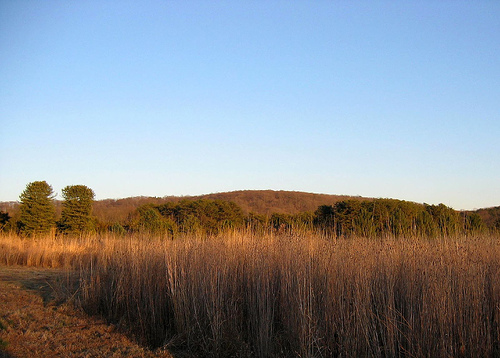
Prairie near sunset, Bernheim Forest and Arboretum
(*photo
credit)
October 26, 2008
Expressing Our Love of God and Neighbor
From the
earliest times I have found it hard to love God with everything I have in my
being; the striving for an insight continues. I do note that Jesus ties this
command to love God with that of loving our neighbor as ourselves.
Interesting! Jesus knows something more than we; we must interconnect the
love of God with love of neighbor and not see him or her as to far removed.
We show our wholehearted love of God through an openness to love of
neighbor, and our lack of love of neighbor is the indicator that our gas
tank of love for God is running low.
The recharging
of our store of love is involved in neighborly love, not just uttering the
words of love, which are more easily said than done. The difficulty is
loving our neighbor whom we can see in all his or her imperfections. While
that person is an indicator of our journey in love, we still look longingly
at our goal and source -- the Alpha and Omega of our lives. Only through
inspiration do we discover that the goal of our love is also the source of
it and our own efforts cannot create the love; we can only respond to what
is already being offered. God is love.
Is loving the
ultimate conundrum (a puzzling problem)? Maybe the solution is that we do
not have the power to effect a solution on our own. For the humble of
heart, God is the giver of all good things and certainly love is something
good stemming from all Love. If we are open to God's love realizing our own
powerlessness, we discover that each new increment of compassion and care is
all due to an openness to the flooding of Love by our Creator. We enter
into others' lives; we begin to love them as we do ourselves.
As the puzzle
begins to unravel, we become ever more grateful to the God who gives all
good things, and even come to realize that our gratitude is a gift from
God. As divine gifts become more evident to us, the more we rest in God's
goodness and love. Thus we have not come to love on our own by some human
effort, but rather we have come by opening ourselves to God's love through
an acknowledgment of our powerlessness. We realize this in extending the
openness to our brothers and sisters wherever they are. All, not just me or
you or our relatives and friends, but all are now part of our love. The
greater our openness, the more God's love floods our soul and we become ever
more loving people.
This new-found
loving exercise is not just between me and God but includes our "neighbors."
The whole-heartedness extends to them as well, for God loves them dearly.
We are open but we are also limited in what we can do. Being aware of our
limited efforts is a humble way of acknowledging the good in others that we
do not envy but rather champion and bless. We pray that our neighbors will
love in turn and we bless them with a good will to achieve deeds that we
cannot do alone. Our love and good will is itself a movement of love and
thus we participate in the good they can do.
Prayer:
Lord give us the openness to love all wholeheartedly.
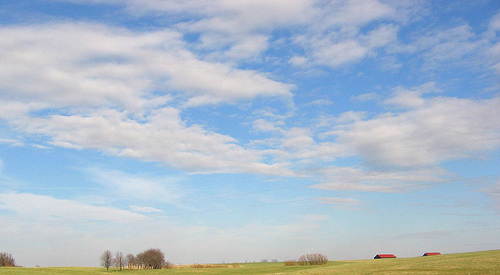
A mid-autumn day, blue sky above expansive green field, a brisk
wind.
(*photo
credit)
October 27,
2008 Dressing for the Season
The phrase to
"always be prepared" seems to be more meaningful in autumn than any other
season, especially for those who like to dress informally in summer, and try
to make the season extend beyond its limits. Summer comfort and winter
protection, not ostentation and fashion, should always be the primary
criteria for clothing choice -- but are they? Late October is the perfect
time to see others under- or over-dressed, and that may be due to false
expectations and lack of preparedness.
Autumn days
catch us off-guard for the foibles of day and night temperatures always keep
us guessing between Indian summer heat and October night chills. We become
perplexed as to what to take along when hiking or going to an evening ball
game or an event that includes both afternoon sun and evening chilly breezes
-- and changing clothes is almost impossible. Such is the season! It is
easy to say, "Don't chill" and "Don't overheat," for either can lead to
common colds or flu. Being physically fit for the season is somewhat
related to our preparedness and the unexpected changes in temperature. In
order to be safe we ought to remember to carry extra protective items: a
warm but non-bulky sweater, gloves, warm socks, cap, and even a scarf -- all
of which can be stored in a backpack or locker. The right underclothing is
more problematic.
Hypothermia can
occur over a wide range of temperatures while hiking or camping or after
plunging into cold water. The nearest I came to it was on a rainy night
after a long bike trip culminating in a five-mile bike climb up Mount
Olympia in Washington. We did not have enough high energy food and we
couldn't start a camp fire because all the fuel was damp; we quickly hit the
sack but that was not satisfying. My sleeping bag was not heavy enough, so
I began to shiver violently, and we traded sleeping bags after building a
thick mattress of skunk cabbage, which smelled bad but provided ground
insulation. I lived through it but resolved to always be prepared.
Autumn travel may
involve the need for a variety of garments. A combination of wool and some
of the modern thermal wicking synthetic fabrics proves comfortable and
helpful in not getting chilled in times of cold weather. Virtually every
time I have gone to Chicago, the windy city, I have forgotten that the
temperature is not as balmy as it was where I left. Over time one solution
is to study weather forecasts for destinations before packing and
departure. Take along at least some waterproof plastic sheeting if you
don't want to pack the more bulky conventional rain gear. Winter sweaters,
caps, gloves and heavy socks often prove welcome and are a good guarantee
against colds.
Prayer:
Lord give us foresight to see what is needed and to do it for our own health
and better performance.

Mother with hand-sewn quilt, "Bow-Tie" pattern
(*photo
credit)
October 28,
2008 Attending the Shut-Ins
October's
brilliant colors are rapidly fading and we prepare for a less colorful
November. Gradually the leaves fall, the sun gives way to misty days, and
chilly evenings become the ordinary condition. It can be a melancholy time
for many, and especially difficult for shut-ins. Their freedom to move
about is more restricted, and they expect to see the four walls in the
coming winter. The upcoming two-month holiday season, which really starts
in less than a month, is much easier for the more mobile. For the shut-ins
it is a time when it is a little harder to smile.
Through our
visits we can enliven. Autumn is the time to increase the frequency and
duration of visits to shut-ins. We reaffirm for them the power of their
prayers when offering their own sufferings in union with the crucified Jesus
-- now extended in space and time through the Sacrifice of the Mass. Even
the acceptance of one's immobility is itself a valuable contribution to the
total renewing of our troubled Earth and a participation in the healing
process that must occur. We announce the Good News that each person has
much more to do than await the universal condition of inevitable dying;
rather it is far more important to affirm living -- an equally universal
aspiration and real possibility.
Besides giving
a spiritual encouragement some of us with energy can actually enhance the
surroundings of the shut-ins; we can do this through a change of
decorations with the seasons, through a houseplant brought indoors, through
some colorful periodicals or other creative innovations. Maybe it is a
prayer card or a dessert or just a new story that is worth sharing on a
visiting occasion. Truly, we should also encourage the caregivers who spend
many hours at modest compensation assisting shut-ins, and doing so with a
smile.
Life is precious
and, while we need not extend it through extraordinary means, we ought to
celebrate it when and where we can. As visitors we share the value of that
life, for non-verbally we profess our belief; shut-ins are quick to realize
if we do not regard their lives as of value. Thus our prayer before a visit
is to give genuine and enthusiastic encouragement. Let's reaffirm to
shut-ins that a vocation of acceptance in joy and gratitude is preaching
Good News even while shut in. Suffering offered in union with Jesus is
never lost -- for all suffering cheerfully undertaken has immense value.
Our compassion as co-sufferers is transparent, and they grasp our firm
belief that we can fill up what is wanting in the suffering of Christ (Col.
1:24) for his body the Church. The challenge is to extend Good News through
enthusiasm, and shut-ins can be key exactly where they are located and
without venturing beyond. Cheerful shut-ins are God's gift to us; their
cheerfulness is an inspiration to a tired world; their joy is a blessing.
Prayer:
Lord, teach us to see your power working among shut-ins so they can preach
Good News to those who care for them and come to visit them, and help them
do this at this season.
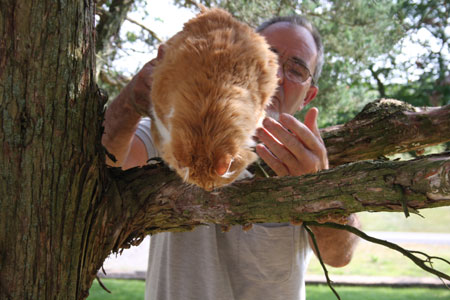
Helping a cat find her way out of a tree
(*photo
credit)
October 29, 2008
Choosing When and Where to Use Synthetics
Plastics are
synthetic polymeric chemical materials generally made from petroleum
products and used in a multitude of household and other commercial items
today. While we have come to use and recycle plastic containers and
packaging (that certainly weigh less than glass), we realize that synthetics
require non-renewable resources as sources and in processing. While natural
products generally require less resource extraction and processing, the
natural is not automatically the better. When and where are we justified in
using a synthetic in place of a natural product? Here are some conditions
for consideration:
Improve
outdoor activity. Synthetics improve recreational activities such as
hiking, biking, and camping by reducing bulk, by protecting better from the
elements, and by being more durable as sleeping bags, ponchos, drop cloths,
or backpacks. In some cases natural products are included as part of the
equipment and that must be considered as well.
Wear better
and over longer lifetime. Everyday purely synthetic or mixed
synthetic/natural clothing such as socks, gloves, rain wear, swimming wear
and underwear may last longer or protect better from sweat or rain. Many of
the newer and better grades of durable glues and sealants fit into this
category.
Are stronger
and safer. Some synthetic materials, such as nylon rope for climbing
are a vast improvement over natural fibers. Certain plastic materials may
be able to withstand the weather as well as cloth weather-protecting
coverings, and still breathe as do many traditional natural fiber cloth
coverings. Some plastics replace inherently dangerous glass products which
are breakable in the hands of infants and others. Children's recreational
equipment such as slides and playpens may be made of plastic without the
sharp edges and corrosion found in metal counterparts.
Are
versatile, easier to store, able to insulate well and are light weight.
Many new synthetic buildings materials that do not out-gas (as in the case
of mobile home construction materials that emitted formaldehyde) are
excellent for covers and roofing, and can be translucent and fairly
durable. The shipping and storage containers may be stronger, lighter in
weight and thus take less transport energy, and can be molded to take less
space. Several brands of sidings for greenhouses have many of the qualities
for maximizing beneficial radiation as well as durability and are safer to
handle. Styrofoam packing makes good insulation.
Caution again!
Synthetics and especially plastics may leach plasticizers and solvents,
decompose in sunlight and air, be quite combustible, lose their strength,
melt at low temperature, and do not easily biodegrade when entering the
waste stream.
Prayer:
Lord, help us to discern spiritual and physical things, and to know
when to use them wisely and well.
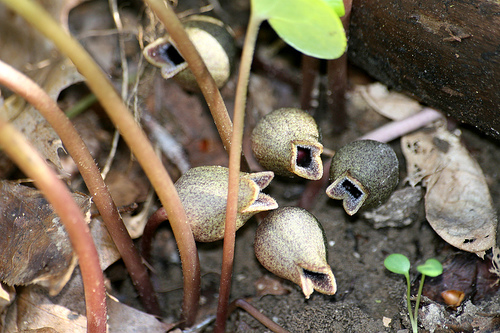
Little brown jug, Hexastylis arifolia
(*photo
credit)
October 30, 2008
Greening Tourist Areas
Mid-autumn is an
ideal time for people to come and see our scenic areas here in Appalachia.
While the green of summer wanes, we ought to give special attention to
making the region more colorful and yet keep it ecologically green for all
seasons. Some ways to do this may include the following:
Construction
of bike paths. One of the
best additions to our region would be to allow the bikes freer access to
scenic sites. Most of our roadways are far too narrow and dangerous.
Public
transportation accessibility. Allowing fewer private vehicles to tour
parks such as the Great Smoky Mountain National Park by increasing the use
of public vehicles; this would do much to improve air conditions in the
Appalachian range. We should also seek to improve our public transportation
in all parts of our region so that non-drivers can experience our region.
Water cleanup
programs. Many of our streams are well monitored, but volunteer
cleanup programs each year assist in giving a better appearance to lakes and
free-flowing waterways.
Reduction of
the billboard jungle. Billboards pollute visibly and yet their messages
are sought by many travelers. Federal and state posted signs for lodging,
fuel and food could be more plentiful on all major state and federal
highways. Clustered signs for major and minor lodging and eating places
would be an advantage for smaller businesses as well as for the larger
ones. Additional promotion through websites and printed information could
replace billboards as a means of informing travelers.
Off-road
vehicles registration. All too often local residents are plagued by
off-road vehicles that trespass, move across barriers and up stream beds,
damaging as they go. All too often there are not enough police to protect
from immediate damage, and the culprits expect that they can continue their
activities.
Solar/wind
energy applications. Reducing the use of non-renewable energy would
eventually reduce surface mining of coal, which scars the landscape. Solar
energy will become more prominent with the coming years as non-renewables
become more costly.
Waste pickup.
More recycling centers along with subsidized and supervised garbage
collection facilities will have some effect in beautifying the landscape.
Deposit bottle legislation could assist in reducing litter as well.
Systematic
removal of invasive species. This would have to be a rather expensive
undertaking, especially with reference to kudzu eradication. Invasive
species problems are becoming serious at scenic locations where native
species are under attack.
Prayer:
Lord, help us to improve our scenic sites.
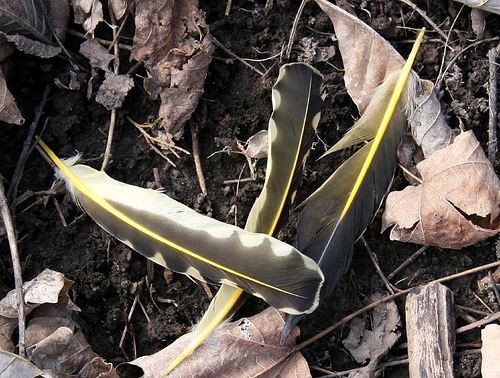
Evening
grosbeak (Coccothraustes vespertinus) feathers
(*photo
credit)
October 31,
2008 Celebrating the Eve of All Hallows
Like many
Christians I find this day hard to celebrate. The day has a pagan
connotation, design, theme and educational content, and so the darkness of
costume and scary conditions are unappealing. Can we find anything positive
here?
"Baptizing"
-- During the entire history of the Church many feasts originated as
existing pagan ones that were transformed by new themes. Such is Halloween,
but what do we celebrate? The original feast was dark and death dealing
(graves, corpses, ghosts, ghouls, skeletons) and this has continued. Lively
talks should coopt the demons and vampires for this is what the feast of all
saints has been meant to do. Yes, this is a challenge.
*
Highlighting -- Give this day special attention and highlight something
that is ordinary about life on "Halloween." One of the best storytelling
opportunities is to bring out the best -- Good News -- of people who helped
others in some way and were the legions that we wish to honor tomorrow on
All Saints Day.
* Decorating
-- Replace drab colors with bright ones, scary scenes with pleasant ones,
death with life, replace witch hunts with social party games and treasure
searches with discovery games with pleasant but complex clues and routes.
* Skit
performing -- Take costumed tots to visit the ill or shut-ins and have
the kids perform a skit and be a treat for them -- "a double treat," not a
trick or treat.
* Caroling
-- Public singing does not have to be limited to Christmas or other
religious festivities. Make Halloween a day to spread the word that carols
celebrate life in its fullness.
* Costuming
-- Halloween can certainly be celebrated in angelic rather than in demonic
ways. Since tomorrow is a feast day, consider a saint's costume if such can
be creatively conceived -- far beyond my abilities, but some can do this
well.
*
Story-telling -- The lives of good folks ought to live after them for
they vitalize us even after they depart the scene. The stories are multiple
and can include those of recognized saints and heroes or those of people
little known outside of a given community. However, the stories are worth
and celebrating.
* Treating
-- At times we suggest treats that are not candy and cookie varieties and
these ought to be restated as approved snacks for Halloween even if we are
expected to open the door to the traditional trick and treating little
ones. Consider stocking apples and other fruit; granola bars and baked
goods; unadorned popcorn or peanuts; yogurt dips and other treats. Many
parents expect gifts to be wrapped and sealed as a safety measure.
Prayer:
Lord teach us to be creative especially at Halloween. |